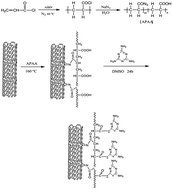Fabrication and characterization of antistatic epoxy composite with multi-walled carbon nanotube-functionalized melamine foam
Abstract
A novel strategy for synthesizing an antistatic epoxy composite was carried out. Pre-embedded antistatic melamine foam was first synthesized and then used to prepare an antistatic epoxy composite. Azidized polyacrylic acid (APAA) was grafted onto multiwalled carbon nanotubes (APAA-MWCNTs) by direct functional modification of the MWCNT sidewalls. Melamine was then covalently bonded to MWCNTs (MA-APAA-MWCNTs). The chemical structure of MA-APAA-MWCNTs was characterized by FT-IR spectroscopy, EDS, TGA, Raman spectroscopy, and TEM. As an antistatic agent, MA-APAA-MWCNTs utilized the functional groups of the surface to participate in the formation of melamine foam by reaction with paraformaldehyde. The surface resistivity was decreased to 3.6 × 108 Ω sq−1 when the loading of MWCNTs was 2.4 kg m−3. The prepared antistatic foam at different compression ratios was immersed in epoxy resin, which was then cured. When the compression ratio reached 40%, the surface resistivity and volume resistivity, respectively, reached 1.05 × 108 Ω sq−1 and 3.5 × 108 Ω cm, thereby achieving an antistatic effect.



 Please wait while we load your content...
Please wait while we load your content...